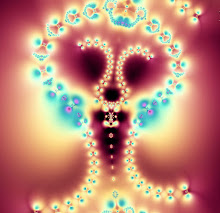Peony. Fractal created by Lynn with Apophysis.
The peony or paeony is a flowering plant in the genus Paeonia, the only genus in the family Paeoniaceae. Peonies are native to Asia, Europe and Western North America. Scientists differ on the number of species that can be distinguished, ranging from 25 to 40, although the current consensus is 33 known species. The relationships between the species need to be further clarified.
Most are herbaceous perennial plants 0.25–1 metre tall, but some are woody shrubs 0.25–3.5 metres tall. They have compound, deeply lobed leaves and large, often fragrant flowers, in colors ranging from purple and pink to red, white or yellow, in late spring and early summer. The flowers have a short blooming season, usually only 7–10 days.
Peonies are popular garden plants in temperate regions. Herbaceous peonies are also sold as cut flowers on a large scale, although generally only available in late spring and early summer.
Meaning In the language of flowers, the peony carries the symbolic meaning of romance, compassion, good luck, prosperity, a happy marriage, and even bashfulness. In their native China, peonies are often referred to as the “queen of flowers” and are the official state flower of Indiana.
https://www.petalrepublic.com/peonies-flowers/
Peony. Fractal created by Alida, She used Fractal Explorer
The first generation of Kao, wild peony, Ranunculaceae, and medicinal
genus, was founded in 1800 meters in Baiyun Mountain, Song County, Henan. Transplanted by Cui Yueqi, the owner of the house, in May 1958, after 27 years of labor and land, the plant chapter of "Henan Geography Knowledge Expo" was filmed by China Education Television in April 2017. The height of the tree is 1.7 meters, the diameter of the canopy is more than two meters, and the number of flowers will reach 350 in the future. The peony is among the longest-used flowers in Eastern culture. Along with the plum blossom, it is a traditional floral symbol of China, where the Paeonia suffruticosa is called (mǔdān). It is also known as "flower of riches and honour" or "king of the flowers", and is used symbolically in Chinese art.
In 1903, the Qing dynasty declared the peony as the national flower. Currently, the Republic of China government in Taiwan designates the plum blossom as the national flower, while the People's Republic of China government has no legally designated national flower. In 1994, the peony was proposed as the national flower after a nationwide poll, but the National People's Congress failed to ratify the selection. In 2003, another selection process was initiated, but no choice has been made to date.
The ancient Chinese city Luoyang has a reputation as a cultivation centre for the peonies. Throughout Chinese history, peonies in Luoyang have been said to be the finest in the country. Dozens of peony exhibitions and shows are still held there annually.
In the Middle Ages, peonies were often painted with their ripe seed-capsules, since it was the seeds, not the flowers, which were medically significant. Ancient superstition dictated that great care be taken not to be seen by a woodpecker while picking the plant's fruit, or the bird might peck out one's eyes.
The red flowers of the species Paeonia peregrina are important in Serbian folklore. Known as Kosovo peonies (Serbian: косовски божур, kosovski božur), they are said to represent the blood of Serbian warriors who died in the Battle of Kosovo.
In 1957, the Indiana General Assembly passed a law to make the peony the state flower of Indiana, a title which it holds to this day. It replaced the zinnia, which had been the state flower since 1931.[37]
Mischievous nymphs were said to hide in the petals of the Peony, giving it the meaning of Shame or Bashfulness in the Language of Flowers. While the peony takes several years to re-establish itself when moved, it blooms annually for decades once it has done so.
Peonies tend to attract ants to the flower buds. This is due to the nectar that forms on the outside of the flower buds, and is not required for the plants' own pollination or other growth. The presence of ants is thought to provide some deterrence to other harmful insects though, so the production of ant-attracting nectar is plausibly a functional adaptation. Ants do not harm the plants.
Peonies are a common subject in tattoos, often used along with koi-fish. The popular use of peonies in Japanese tattoo was inspired by the ukiyo-e artist Utagawa Kuniyoshi's illustrations of Suikoden, a classical Chinese novel. His paintings of warrior-heroes covered in pictorial tattoos included lions, tigers, dragons, koi fish, and peonies, among other symbols. The peony became a masculine motif, associated with a devil-may-care attitude and disregard for consequence.
Famous painters of peonies have included Conrad Gessner (ca. 1550) and Auguste Renoir in 1879. Paeonia officinalis can be found in the altar picture of Maria im Rosenhag by Schongauer in the former Dominican Church in Colmar.[34] The Italian Jesuit, painter and architect Giuseppe Castiglione (1688-1766), who worked at the court of the Qianlong Emperor in the Qing dynasty, painted peonies.










0 Comments:
Post a Comment